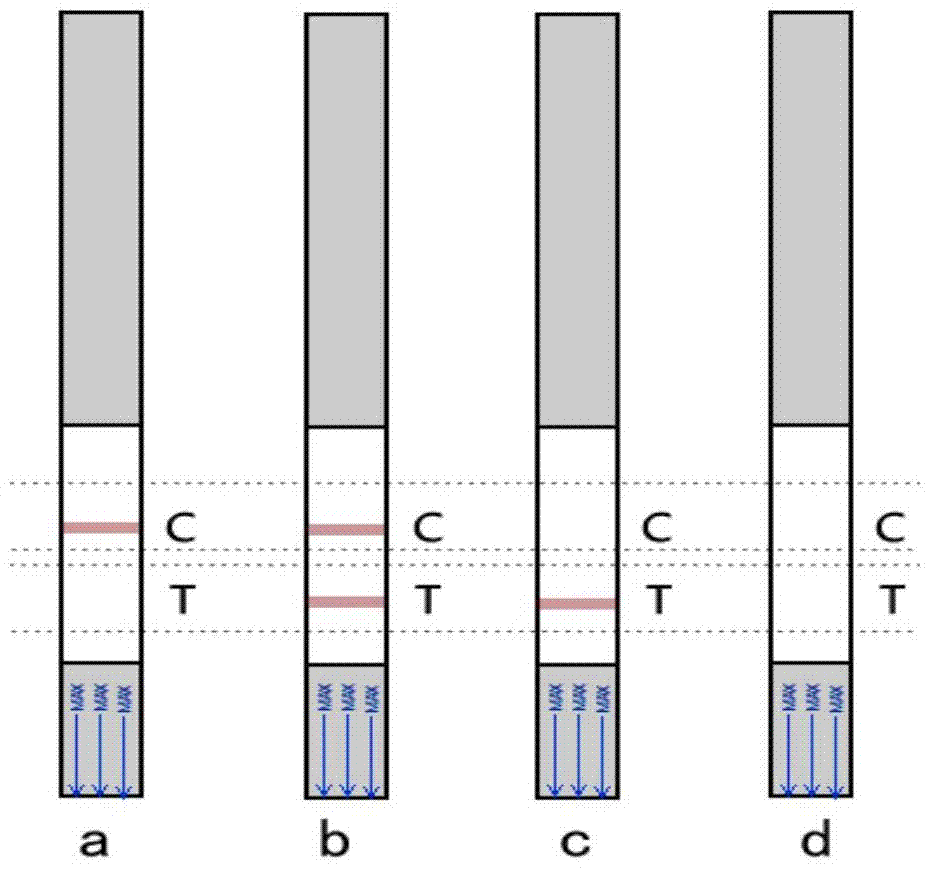A kit and method for detecting Tilletia dwarf
A technology of Tilletia dwarf and a kit, which is applied in the field of kits for detecting Tilletia dwarf, can solve problems such as failure to separate
- Summary
- Abstract
- Description
- Claims
- Application Information
AI Technical Summary
Problems solved by technology
Method used
Image
Examples
Embodiment 1
[0043] Example 1. Preparation of colloidal gold test paper for detecting Tilletia vulgaris
[0044] Composition of colloidal gold test paper for detection of Tilletia vulgaris
[0045] 1. Micropore reagent
[0046] There is a micro-hole plug on the micro-hole; the bottom of the micro-hole is freeze-dried with Tilletia dwarf monoclonal antibody-colloidal gold marker, the amount of freeze-drying is 50μl;
[0047] Two, test strips ( figure 1 ):
[0048] The test strip is composed of a bottom plate, a sample absorption pad, a reaction film, a water absorption pad, and a protective film;
[0049] The sample absorbent pad 1, the reaction film 2, the absorbent pad 3, and the protective film are sequentially pasted on the bottom plate 6 in order. The end of the sample absorbent pad is connected to the reaction membrane, and the end of the reaction membrane is connected to the absorbent pad. The beginning of the pad is aligned with the beginning of the bottom plate, and the end of the absorbent ...
Embodiment 2
[0090] Example 2. Detection limit and specificity test of Tilletia vulgaris colloidal gold test paper
[0091] (1) Detection limit test
[0092] The standard Tilletia vulgaris (TCK1 teliospore) was diluted to 0, 5, 10, 20 mg / L, and the dilution used was a phosphate buffer with a pH of 7.2 and 0.2 mol / L.
[0093] Use colloidal gold test paper for testing. Add 200μl of sample to the microwell reagent each time, mix well, and after incubating for 5 minutes, insert the test paper into the test. The result is: when 0, 5mg / L Tilletia dwarf is tested, the quality control area of the test strip shows color , The detection area does not show color and is negative; when 10, 20mg / L Tilletia vulgaris is tested, the quality control area and detection area of the test strip are both colored and positive; it shows that the test strip is positive for wheat dwarf The detection limit of Tilletia is 10mg / L.
[0094] (2) Specificity test
[0095] Specificity is often expressed by cross-reaction rate...
Embodiment 3
[0096] Example 3. Application of Tilletia dwarf colloidal gold test paper
[0097] 1. Use test paper to detect Tilletia vulgaris
[0098] The test strip can detect Tilletia vulgaris. The detection method is as follows:
[0099] 1. Detection method
[0100] Add dropwise the sample solution (PBS buffer and cosolvent) to be tested to the microwell reagent. After mixing, incubate for 5 minutes. Insert the MAX line-labeled end of the test paper into the microwell reagent down and watch the results within 5 minutes.
[0101] 2. Judgment of test results
[0102] When the concentration of T. dwarf in the sample is higher than or equal to 10 mg / L, the colloidal gold antibody binds to T. dwarf, and a red band appears in the test area due to the sandwich reaction of the double antibody, which is positive. When the concentration of T. wheat dwarf bacteria in the sample is lower than 10 mg / L, there is no red band in the detection area due to the lack of antibody antigen reaction during the detectio...
PUM
| Property | Measurement | Unit |
|---|---|---|
| Sensitivity | aaaaa | aaaaa |
Abstract
Description
Claims
Application Information
 Login to View More
Login to View More - R&D Engineer
- R&D Manager
- IP Professional
- Industry Leading Data Capabilities
- Powerful AI technology
- Patent DNA Extraction
Browse by: Latest US Patents, China's latest patents, Technical Efficacy Thesaurus, Application Domain, Technology Topic, Popular Technical Reports.
© 2024 PatSnap. All rights reserved.Legal|Privacy policy|Modern Slavery Act Transparency Statement|Sitemap|About US| Contact US: help@patsnap.com










